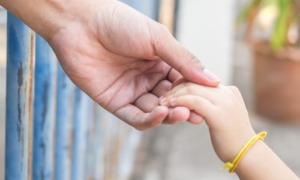Note: This version corrects an error from the printed issue pertaining to the Dads Make a Difference program.
In New York, helping men become better fathers sometimes means helping them get back their driver’s licenses.
In Georgia, it means contracting with technical colleges across the state to help men launch new careers.
In Baltimore, it means teaching the fathers and mothers to work as a team – even if they’ve split up.
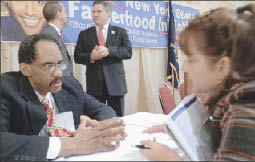 |
|
Ronald Mincy and others lament the decline in funding for fatherhood programs.
Photo: N.Y. Office of Temporary Assistance |
Helping men become better fathers has gotten more complex than ever. That’s because fatherhood initiatives have grown beyond just collecting child support from noncustodial dads, to providing myriad services like parenting skills, GED attainment and job training. And that has required building networks of service providers within communities and even across states.
Those changes can be traced at least to the 1990s, when several foundations, including the Ford, Charles Stewart Mott and Annie E. Casey foundations, funded efforts to study the plight of struggling fathers and focus on helping to stabilize them.
Roland Warren, president of the National Fatherhood Initiative, also credits the U.S. Office of Child Support Enforcement for changing its mindset toward funding such efforts. “For many years, they didn’t have the perspective that their role was to connect fathers to families, so much as it was to connect wallets to kids,” he says. “That’s a sea change.”
The change was prompted in part by financial concerns: As efforts grew to establish the paternity of children and collect child support, so did the amount of money that noncustodial fathers owe. The U.S. Office of Child Support puts the aggregate arrears figure at $107 billion, says Karin Martinson, senior research associate at the Urban Institute.
Many of the fathers can’t afford to pay, and “that’s led to these more service-oriented strategies,” Martinson says.
Warren of the National Fatherhood Initiative notes that fatherhood programs help reduce those child support arrears. The programs are “not just an added expense, but an investment against a $100 billion cost,” he says.
Growth and Cutbacks
Programs have networked with partners throughout their communities to help these dads overcome parenting obstacles – which typically include little or no income, child support debts, criminal records, housing instability, poor educations and strained relationships with their children’s mothers. Most ambitious of all are probably New York and Georgia, which have tried to replicate such networks statewide.
A behind-the-scenes obstacle is that many of these men had no meaningful relationships with their own fathers. “Their knowledge of manhood is kind of distorted and shaped by what they get from the street,” says Joe Jones, whose Center for Urban Families runs a fathering program in Baltimore.
One of the most important services is still the most basic: bringing men together in a way that they’ve never gathered before. “This is where these guys develop bonds with other guys in the same situation,” says Jeffrey Johnson, president of the National Partnership for Community Leadership, which trains organizations to set up fathering programs. “They get to hear other guys’ experiences and come together around challenges they have. … How many outlets, particularly for guys who don’t go to college, are there for guys to talk about their situation?”
However, programs are doing this against a shrinking funding pool. The federal funds that began flowing into the field after welfare reform passed in 1996 have declined significantly, says Ronald B. Mincy, who championed holistic fatherhood programs as a program officer at Ford in the early 1990s.
That has led to some contraction in fatherhood programs and less interaction among them. Warren says foundations are not as involved as before, either. “A lot of the fatherhood programs are struggling around funding, trying to figure out how to sustain their work,” he says.
Some fatherhood programs are partially funded through the federal Healthy Marriage and Responsible Fatherhood Initiative (appropriated at $150 million a year), which was the subject of an analysis released last month by the Government Accountability Office (GAO). Among other things, the report said that although the U.S. Department of Health and Human Services (HHS) uses site visits and progress reports to monitor the grantees, “it lacks mechanisms to identify and target grantees that are not in compliance with grant requirements or are not meeting performance goals.” HHS says it is correcting the problems. (See Report Roundup, page 28.)
The GAO said high schoolers account for about 45 percent of those served through Healthy Marriage grants, whose programs tend to focus on marriage and relationships, while Responsible Fatherhood-funded programs more often serve incarcerated parents and focus more on parenting skills.
These and other issues were discussed in a webinar in March, “Dads in the Mix: The Future of Fatherhood Initiatives,” sponsored by the Chapin Hall Center for Children and the National Governors Association. The presentations and recording can be found at http://www.chapinhall.org; click “Conferences” and scroll to “Governing for Children and Families.”
Fatherhood Programs Mature
Baltimore Responsible Fatherhood Project
Center for Urban Families
(410) 367-5691, http://www.cfuf.org
The Strategy: Improve father-mother relationships and fathers’ parenting skills, and help fathers find jobs, maintain child support payments and steer clear of criminal activity.
Getting Started: The project grew out of an infant mortality program at the Baltimore Health Department that worked with pregnant women and their children. Joe Jones, then an addiction counselor, knew that after a “limited amount of drug treatment,” many of the women would go back to their children’s fathers. “These men were much more influential on these women’s behavior than I could ever be,” he says.
In 1992, Jones persuaded his superiors to begin a pilot program to work with the fathers. In 1998, he created the nonprofit Center for Urban Families, with support from the health department, local family foundations and national foundations, including Ford. Jones is CEO of the agency, which runs several programs.
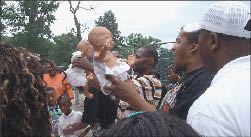 |
|
Baby Steps: The Center for Urban Families helps men develop parenting skills.
Photo: Center for Urban Families |
How it Works: The project serves men through a curriculum and through links to services, including the center’s work force development program, an on-site GED program operated in partnership with the Community College of Baltimore, and a center program called Partners for Success, which helps couples develop financial literacy skills and determine how to fit together their career and life goals. “We help them think about how, as a couple, they’re going to execute that plan,” touching on issues like budgeting and day-to-day scheduling of work and child care, Jones says.
For couples who are not together, he adds, “We try to get mom and dad to understand that there are vehicles and tools they can use to work together, so the child will always have access to both parents.” That requires overcoming the fact that most of the men didn’t have meaningful relationships with their own fathers.
People Served: More than 100 fathers per year. The center recruits them primarily through partners like family service organizations, family courts and child support agencies, which distribute materials from the program and refer men to it. The agency also recruits directly through street outreach, literally knocking on doors to find “the population that is most disconnected and isolated,” Jones says. “We help them understand that here’s a place for fathers.”
Staff: The center has about 32 employees, including three at the Fatherhood Project, six on the work force development team and three in Partners for Success.
Money: The center’s budget totals $4.2 million. The Fatherhood Project runs on approximately $500,000, from private funders, including the Abell Foundation, Mathematica Policy Research, the Weinberg Foundation and the Krieger Fund. The funding from Mathematica originates from the U.S. Administration for Children and Families, which contracted with the research firm to look for and study best practices in fatherhood programs.
Results: There has been no recent outside evaluation.
Dads Make a Difference
Healthy Families San Angelo
San Angelo, Texas
(325) 658-2771, http://www.hfsatx.com
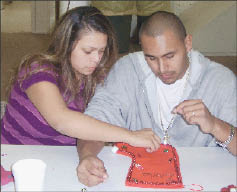 |
| Photo: Healthy Families San Angelo |
The Strategy: Select pairs of parents and focus on their relationships as much as the father/child relationship. The program strives to improve parent-child interactions, child development, couple relationship skills and the ability of both parents to provide for the children financially. The parents do not have to live together.
Getting Started: Healthy Families began in 1993 as a traditional family-centered program, but too often that meant “mother and child” only, says Gardner Wiseheart, director of programs and services. “We realized we needed to develop some strategies for bringing in dads.”
About four years ago, Mathematica Policy Research asked the agency to participate in the federal Healthy Marriage Initiative as one of six sites that would investigate and help research “what goes into supporting low-income couples in marriage,” Wiseheart says.
 |
|
Staying active with children is a key fathering strategy.
|
How it Works: Services in the 18- to 24-month program begin before or at the same time as the birth of the child.
Healthy Families staffers visit unmarried parents of newborns at local hospitals and, if they gain permission, screen their charts to look for various risk factors – like being unmarried or having no telephone – before asking if they would be interested in participating.
“It’s a structured admission process, as opposed to just an open-ended, anybody-who-walks-in-the-door kind of process,” Wiseheart says. “We’re real focused on who we target.”
The program’s core component consists of home visit that focus building healthy parent-child interactions and the couple’s relationship while promoting self-sufficiency. Dads can participate in a number of other activites, including a Dads Group, Couples Group, Employment Group, Anger Management Group, Sports Group and Daddy and Me Play Group.
Caseworkers help the parents set goals, which they strive to achieve through a “real tight curriculum,” Wiseheart says. For example, “We teach dads what they need to do to help their kid be ready for school, to learn, without any development delays.” Other goals for the dads include fostering positive interactions with their child’s mother, improving problem-solving skills, and gaining education and job skills.
Couples participate in home visits, special groups for fathers and for mothers, couples skills groups, and social activities, such as holiday gatherings and summer cookouts. The program helps clients get GED instruction, drug treatment and legal assistance.
Case workers meet with couples weekly at first, then step down, eventually reaching once a month as the parents “become more independent and as they gain more out of the program,” Wiseheart says.
If a relationship breaks up, two “dad guys” reach out to fathers, Wiseheart says, “to keep dad connected with the child and to maintain the relationship with the mother.”
People Served: The program serves about 250 families per year, which comes to roughly 875 individuals, including children by other partners and those other partners.
Staff: The eight home visitors take on caseloads of about 25 apiece.
Money: About half (48 percent) of the agency’s budget comes from Mathematica Policy Research, Inc., after originating at the federal Department of Health and Human Services. The state of Texas and the Office of the Attorney General each contribute 20 percent and 12 percent comes from private sources.
Results: The Dads Make a Difference Program has a 94 percent retention rate, according to the agency’s own recordkeeping. Although nearly half (47 percent) of fathers did not live with their child’s mother, all had contact at least three to four times per week with their children and 82 percent had daily contact in fiscal year 2008.
FATHER Project
Minneapolis
(612) 724-3539, http://www.goodwilleasterseals.org
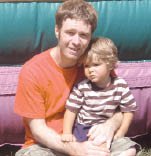 |
|
Child’s play is one of the FATHER Project’s strategies.
Photo: FATHER Project |
The Strategy: Contract with about a dozen partners who provide services to noncustodial parents, including legal services, parenting education, early childhood education, couples counseling, GED preparation, employment and training, and case management.
Getting Started: Founded in 1999 as one of 10 national “Partners for Fragile Families” demonstration projects, the project has migrated from its original home at the Minneapolis Youth Coordinating Board to Goodwill/Easter Seals.
How it Works: Peer-led facilitated support groups have become the program’s key offering. “That’s not what they come in requesting,” says Guy Bowling, project manager. “But that’s what keeps them: getting support from experienced staff who are parents and who are trained, and also support from other peers in the program who are either where they’re at, or who have overcome what they’re facing.”
The project offers a “citizen father” track in partnership with the University of Minnesota, Bowling says. Fathers who have excelled in the program are trained to carry out leadership activities in communities. “They’re doing presentations to schools, churches, prisons and community-based organizations about the positive impact of an involved father,” Bowling says.
People Served: About 200 fathers per year.
Staff: Eight full-time employees and “a whole host of partners on site.” The partners include organizations that focus on Latino and Native American families.
Money: The $600,000 annual budget is funded by $500,000 a year through a Promoting Responsible Fatherhood grant from the U.S. Administration for Children and Families, supplemented by grants from such foundations as McKnight and Phillips.
Georgia Fatherhood Program
Technical College System of Georgia
Atlanta
(404) 679-1654
http://www.technicalcollegesystemofgeorgia.org/noncustodial_fathers.php
 |
| Photo: Georgia Fatherhood Program |
The Strategy: A statewide fatherhood support program that contracts with public colleges to provide an array of services, from job training to helping to expunge criminal records. “It put a program within 50 miles of every resident,” says Robert D. Johnson, former state fatherhood technical consultant. “We decided rather than reinvent the wheel, we could integrate our fatherhood program in the technical colleges.”
Getting Started: The program began in 1997 as a pilot at seven technical colleges, funded by the state Department of Human Resources, then expanded statewide under contracts with all 33 of Georgia’s public state technical colleges. Initially, the program served only noncustodial parents under court orders to pay child support.
 |
|
Job training and other classroom help is the focus in Georgia.
|
How it Works: The program provides short-term training courses at the technical colleges, where participants can get technical credits or work toward college degrees, says Arlana Murray, program operations specialist.
It focuses on education, training and job placement. Services include workshops in such subjects as GED preparation and résumé writing, life-skills training, family budgeting, and parental rights and responsibilities, along with help in obtaining visitation rights.
People Served: The program has moved to the state Department of Labor, with significantly less funding; the number of colleges under contract has shrunk from 33 to 12.
For the fiscal year that ended June 30, the program served 2,750 people, of whom 2,445 were men, Murray says. The program has broadened to include custodial parents.
Staff: Three staffers in the technical colleges’ central office and one at each of the schools.
Money: The previous budget of $2.8 million has been sliced to $800,000.
Results: The last soup-to-nuts evaluation of the program, conducted about five years ago by the University of Georgia, concluded that it worked well overall, placing about 60 percent of its participants in employment.
But the study found the program needed to work more closely with other state agencies to reduce red tape. “We had a form to fill out, child services had a form to fill out, everybody had forms,” Murray says. The streamlining that was recommended “never did come to pass.”
During the fiscal year that ended June 30, the program helped find employment for 1,624 of the people it served, Murray says.
Fatherhood Initiative
New York Office of Temporary and Disability Assistance
(518) 408-4971, http://www.otda.state.ny.us/main/fatherhood
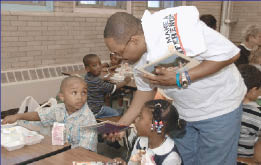 |
|
Braswell, seen here talking to children at a fatherhood picnic, seeks to get dads “to the point where they can become self-sufficient and then begin to take care of their families.”
Photo: N.Y. Office of Temporary Assistance |
The Strategy: Take a holistic approach by funding five sites, each of which must provide employment-related services, educational assistance, help with child support, parenting classes and anything else “that would help a noncustodial parent become involved in the lives of their children,” says Kenneth Braswell, director of the state’s Fatherhood Initiative, which is housed in the Office of Temporary and Disability Assistance.
Ronald B. Mincy, the former Ford Foundation program officer who is now a professor at the Columbia University School of Social Work, says the pilot program “is one of the bigger, more well-functioning initiatives in the country.”
Getting Started: The initiative began in 2006 and is funded through 2009.
How it Works: The sites subcontract with other providers, creating a network of government and private agencies that provide services. Braswell estimates that 30 organizations help to run the pilot programs.
For example, one of the pilot sites is the Parent Success Initiative, a Syracuse nonprofit that focuses on employment. Its local subcontractors include larger nonprofits, local social service agencies, educational institutions and for-profit consultants and credit counselors, says Mike Irwin, the project director.
The initiative tries to deal with just about anything that interferes with the fathers’ stability, like helping a man get back a driver’s license that the state revoked because he owed too much child support. The objective, Braswell says, is to figure out, “How do we work with other state agencies … to give [the men] some breathing room, to get them to the point where they can become self-sufficient and then begin to take care of their families?”
People Served: The state program has served more than 2,200 noncustodial parents in the past two-plus years, 93 percent of whom are fathers. The sites get a steady stream of clients through local court referrals, mainly family courts, although the Buffalo program, which includes a substance-abuse recovery component, draws from drug courts, as well.
Staff: The state-level staff consists of Braswell and one other full-timer. As an example of the sites, the Syracuse program has 10 employees ranging across the lead agency and its subcontractors, says Irwin, who is the only employee of the Parent Success Initiative itself.
Money: The state has budgeted $3 million per year over three years. Braswell hopes for a mix of funding from the state, the federal government and foundations to continue the program past next year.
Results: In October, Mincy presented preliminary results of research he conducted on the pilot sites. Those results focused on process; Mincy says the contractors are doing well at finding clients and providing services, thanks largely to how the state initiative was set up.
“They were smart enough to fund a serious outreach effort designed to create cross-site collaboration and learning, and a feedback loop between the child support agency and the Office of Temporary and Disability Assistance,” Mincy says. “That has generated a lot of activity and a lot of service. … The recruitment problems that have plagued the field are just not a problem.”
Mincy says that next year he will report data on clients’ employment rates, child support payments and involvement with their children.



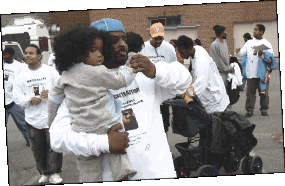






_fmt.gif)



